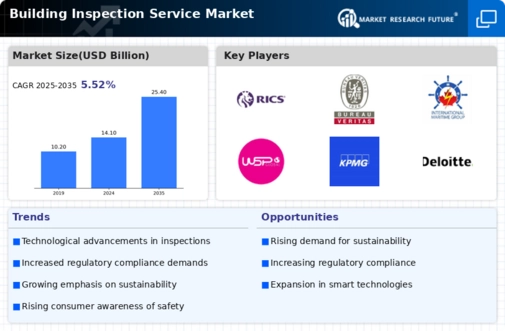Growing Real Estate Market
The Building Inspection Service Market is significantly influenced by the expansion of the real estate market. As property transactions increase, the necessity for thorough inspections prior to sales becomes paramount. In 2025, the real estate sector is expected to grow by approximately 6%, leading to a corresponding rise in demand for building inspection services. Buyers are increasingly seeking assurance regarding the condition of properties, prompting sellers to invest in pre-inspection services to facilitate smoother transactions. This trend underscores the critical role of building inspections in the real estate market, as they provide essential information that influences purchasing decisions.
Rising Construction Activities
The Building Inspection Service Market is experiencing a surge in demand due to increasing construction activities across various sectors. As urbanization accelerates, the need for residential, commercial, and industrial buildings rises. In 2025, the construction sector is projected to grow by approximately 5% annually, necessitating thorough inspections to ensure compliance with safety and quality standards. This growth in construction activities directly correlates with the demand for building inspection services, as stakeholders seek to mitigate risks associated with structural integrity and safety. Consequently, the Building Inspection Service Market is poised to benefit from this upward trend, as more projects require comprehensive inspections to adhere to regulatory requirements and ensure the longevity of structures.
Increased Awareness of Safety Standards
There is a growing awareness among property owners and developers regarding the importance of safety standards in the Building Inspection Service Market. As incidents of structural failures and safety breaches have been reported, stakeholders are increasingly prioritizing inspections to safeguard lives and investments. This heightened awareness is reflected in the rising number of inspections conducted annually, which has increased by nearly 10% in recent years. Furthermore, regulatory bodies are enforcing stricter safety regulations, compelling property owners to engage inspection services proactively. This trend indicates a robust demand for building inspection services, as compliance with safety standards becomes a critical factor in the construction and real estate sectors.
Technological Advancements in Inspection Processes
The integration of advanced technologies in the Building Inspection Service Market is transforming traditional inspection methods. Innovations such as drones, 3D scanning, and artificial intelligence are enhancing the efficiency and accuracy of inspections. For instance, the use of drones allows inspectors to access hard-to-reach areas, while AI can analyze data to identify potential issues more effectively. As these technologies become more accessible, the market is likely to witness a shift towards more sophisticated inspection processes. This evolution not only improves the quality of inspections but also reduces the time required for assessments, thereby increasing the overall demand for building inspection services.
Environmental Regulations and Sustainability Initiatives
The Building Inspection Service Market is also shaped by the increasing emphasis on environmental regulations and sustainability initiatives. As governments and organizations strive to reduce their carbon footprint, there is a growing demand for inspections that assess compliance with green building standards. This trend is evident in the rising number of certifications for sustainable buildings, which require thorough inspections to ensure adherence to environmental guidelines. In 2025, it is anticipated that the demand for green building inspections will increase by 15%, reflecting a broader commitment to sustainability in construction. Consequently, building inspection services that focus on environmental compliance are likely to see substantial growth.


















Leave a Comment